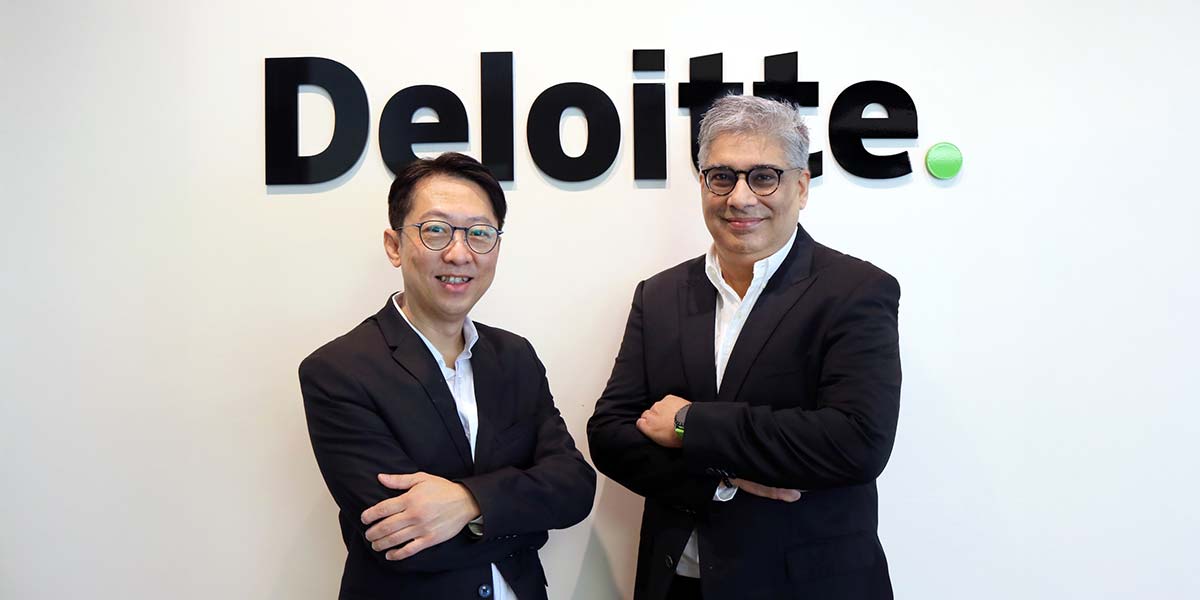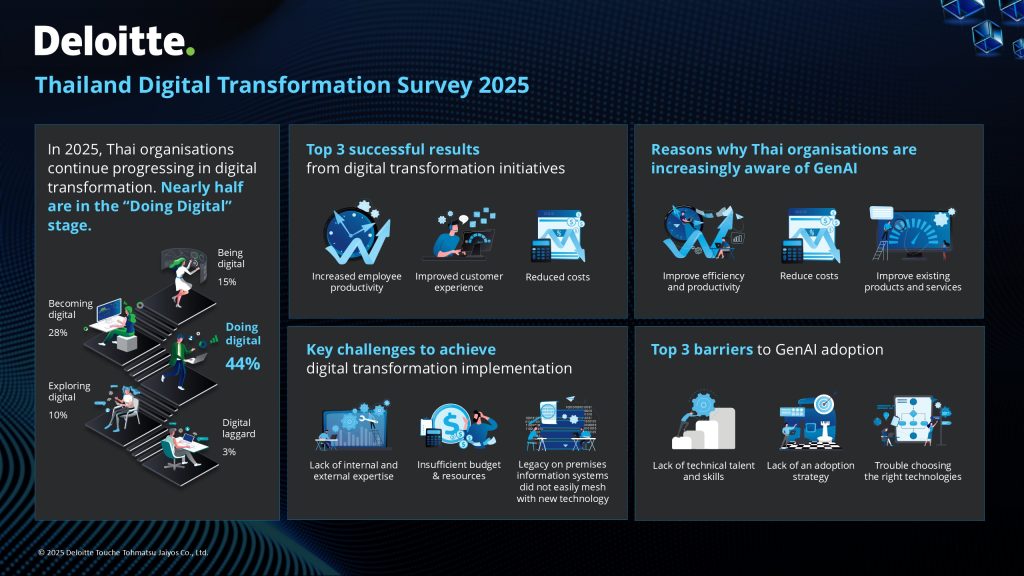- In 2025, Thai organisations continue progressing in digital transformation. Nearly half are in the “Doing Digital” stage.
- Key benefits include improved productivity, enhanced customer experience, and cost reduction. However, the main challenges remain the lack of skills and expertise, insufficient budgets and resources, and reliance on legacy IT systems.
- Thai organisations are increasingly aware of GenAI to enhance efficiency, reduce costs, and improve quality, but still trail behind global benchmarks.
- The top three barriers to GenAI adoption are: lack of technical talent and skills, lack of an adoption strategy, and trouble choosing the right technologies.
Thai businesses continue to adopt digital technologies. According to the Deloitte Thailand Digital Transformation Survey 2025, conducted by Deloitte Thailand for the fifth consecutive year, Thai organisations are increasingly integrating digital into their core operations. Although technology continues to evolve rapidly, adaptability remains a critical factor for organisational survival and competitiveness. In addition, the adoption of Generative AI (GenAI) is becoming more widespread.
Progress on Digital Transformation Among Thai Organisations
In 2025, the status of Thai organisations in digital transformation journey remains consistent with last year’s findings. The largest proportion of organisations (44%) are in the “Doing Digital” stage, followed by 28% in “Becoming Digital” and 15% in “Being Digital.” Meanwhile, the “Exploring Digital” and “Digital Laggard” groups remain in the minority, accounting for 10% and 3%, respectively. These findings indicate a more balanced and cautious approach to digital strategy. Thai organisations no longer see digital transformation as a technology experiment but are now integrating digital into their core business structures with a focus on delivering tangible outcomes.
The top three successful results from digital transformation initiatives among Thai organisations are: increased employee productivity (67%), improved customer experience (61%), and reduced cost (58%). These reflect a strong focus on investments that yield rapid results. Notably, organisations with higher digital readiness are significantly more likely to introduce new products and services.
Key challenges to achieve digital transformation implementation continue to fall under three main areas: a lack of internal and external expertise (35%), insufficient budget and resources (34%), and legacy on premises information systems not easily mesh with new technology (31%). Notably, these have now overtaken last year’s top concern, which was the lack of digital culture readiness.
Technology Investment and GenAI Adoption
Thai organisations continue to prioritize foundational technologies such as traditional web technology (44%), cloud (65%), and mobile applications (57%). Meanwhile, data analytics stands out as the most adopted advanced technology (70%). Large enterprises are more likely to diversify their investments into emerging technologies such as AI, augmented reality/virtual reality (AR/VR), robotics, the Internet of Things (IoT), and blockchain.
However, the most noteworthy technology this year is GenAI, which is gaining significant traction across organisations of all sizes. The survey found that organisations in the “Being Digital” group are twice as likely to adopt data analytics and five times more likely to utilize AI compared to those in the “Digital Laggard” group.
While Thai organisations are increasingly aware of GenAI, leaders of Thai organisations still assess their own GenAI expertise as lower than the global average. Only 5% consider themselves to have “high to very high” levels of expertise, compared to the global average of 44%. Industries leading in GenAI adoption include information technology, media and telecommunications (TMT), and financial services.
Perspectives on GenAI and its Implementation within Organisations
Senior executives hold differing views on GenAI being paid attention in organisational level. Nearly 60% of board of directors and CEOs believe their organisations are not paying sufficient attention to GenAI, while over 80% of CIOs and CTOs believe they are giving it the appropriate level of focus. This gap in perception may affect the pace of adaptation and the organisation’s ability to move forward.
The functions with the highest adoption of GenAI include IT and cybersecurity as well as marketing, sales and customer service. The top five GenAI use cases are: search and knowledge management (68%), content summarisation, meetings, and news (54%), content generation of text, images, video and audio (50%), language translation (48%), and serving as virtual assistants or conversational chatbots (45%).
Barriers to GenAI Adoption
The top three barriers to GenAI adoption are the lack of technical talent and skills (63%), the lack of an adoption strategy (32%), and the trouble choosing the right technologies (24%). These findings highlight the importance of developing a comprehensive strategy and planning for workforce development as critical priorities for organisations.
Mr. Sanjay Sachdev, Director, Technology & Transformation, Deloitte Thailand, stated “Today, many organisations have begun adopting technologies. However, transforming an organisation through digital transformation or even the adoption of GenAI—should not be viewed solely through a technological lens. Business leaders must define clear objectives that align with the organisation’s strategic direction from the outset. Only with this clarity can investments lead to tangible business outcomes.”
Narain Chutijirawong, PhD, Executive Director, Growth, Deloitte Thailand, said “Having gathered insights from executives for the fifth consecutive year, we have realised that, to achieve meaningful progress, organisations should view digital transformation as a journey rather than a one-time project. The digital transformation can only be achieved when all stakeholders in the business ecosystem—both internal and external—understand the business and move forward in the same direction.”






